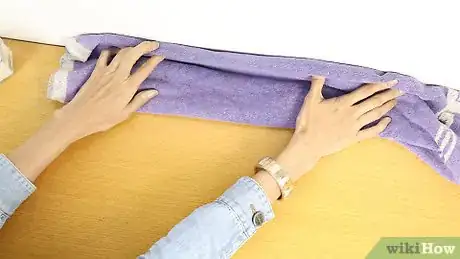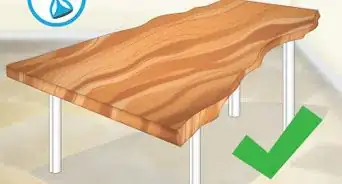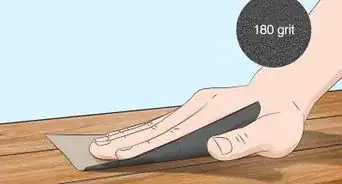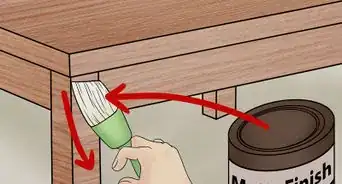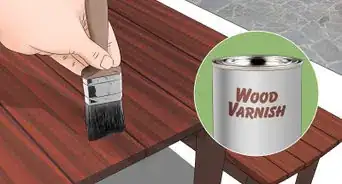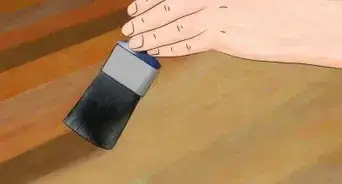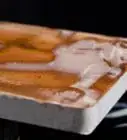This article was co-authored by wikiHow Staff. Our trained team of editors and researchers validate articles for accuracy and comprehensiveness. wikiHow's Content Management Team carefully monitors the work from our editorial staff to ensure that each article is backed by trusted research and meets our high quality standards.
The wikiHow Video Team also followed the article's instructions and verified that they work.
This article has been viewed 102,192 times.
Learn more...
Tung oil is a type of natural drying oil commonly used as a finish in woodworking projects. When applied to a raw surface, the oil hardens to protect and add luster to the wood. After sanding and cleaning the wood surface to remove any previous finish, spread the oil along the grain pattern using a clean, lint-free rag. Allow the oil to soak into the surface for an hour, then sand lightly to promote adhesion. Wait a 3-7 days to apply followup coats. Tung oil may take several weeks to cure completely, but once it does it will provide a resilient, long-lasting layer of protection.
Things You Should Know
- To prepare, clean the surface with a damp cloth and strip away the existing finish before sanding it down and covering the area with a dropcloth.
- Thin the tung oil with a solvent before using a clean rag to rub oil into the wood in the direction of the grain, then let it sit for 30 minutes.
- Let the wood rest for 3-7 days between coats and sand the wood before applying a new one; wait several weeks for the oil to completely cure.
Steps
Preparing Your Work Surface
-
1Clean the wood surface with a damp cloth. Wet the cloth with warm water and wring out the excess moisture. Wipe down the wood using long, linear strokes or smooth circles, working against the grain. When you’re done, give the surface a few minutes to dry to the touch.[1]
- Your wood surface needs to be free of dust, dirt, oil and other messes in order for the tung oil to set up properly.
- A good wipedown also serves to raise the wood grain, which makes sanding more effective and results in a smoother overall finish.
-
2Strip any existing finish with trisodium phosphate (TSP). If you’re working with an object that’s already treated with a varnish or lacquer, you’ll need to remove it before you can apply the tung oil. Mix 2 tablespoons (29.6 ml) of TSP into 1 gallon (3.8 l) of water and use a brush or sponge to spread the liquid over the entire surface. Avoid handling the surface until it’s had time to dry.
- TSP is a highly-effective deep cleaner, but it’s also highly toxic. Always make it a point to wear long-sleeved clothing, rubber gloves, and a respirator or facemask anytime you’re working with the chemical.[2]
- It’s also a good idea to do your stripping in an area with good ventilation (or outside, if possible) to prevent the fumes from becoming overpowering.
Advertisement -
3Sand the surface thoroughly. Run a square of high-grit sandpaper (around 120-grit or finer) over the outer face of the wood using tight circles. This will smooth out imperfections and inconsistencies in the grain. Be sure to sand each and every part of the item you’ll be finishing, including corners, edges, and recessed nooks.[3]
- Sanding is necessary to help the first layer of tung oil settle into the wood.
-
4Wipe down the sanded wood. Go over the surface with your cleaning cloth once more to sweep away the dust generated by sanding. The surface should be entirely free of debris before you begin applying the oil. If the wood is damp, allow it to dry to the touch before proceeding.[4]
- Use a thin dry brush to coax stubborn particles out of creases and grooves.
- Any dust left behind may create imperfections in the finish.
-
5Cover your work area with a dropcloth or tarp. This extra layer will serve as a protective buffer between the wood and its surrounding surfaces. With it in place, you'll be able to work quickly and efficiently without worrying about making an oily mess. When you're finished, simply take your cover outside and spray it off.
- You can also stretch out a few sheets of newspaper if you don't have a tarp or dropcloth on hand.
- Rich natural oils like tung oil can leave permanent stains if they find their way onto absorbent materials.
Coating the Wood
-
1Thin the tung oil with a solvent. Stir together equal parts oil and mineral spirits, turpentine, or organic citrus solvent in a spacious container. Cutting the oil with a solvent makes it easier to apply in multiple thin coats, which will in turn provide a glossier finish and greater durability than a single thick one.
- You shouldn’t need more than a single canister of tung oil for most small projects—1⁄4 gallon (0.95 l) can cover up to 100 square feet of unfinished wood.
- Don’t thin tung oil if you’re planning on treating surfaces that will be used for culinary purposes, like countertops, cutting boards, and spoons. While the oil itself is naturally non-toxic, chemical solvents can leach into foods that come into contact with the surface, making them harmful to ingest.[5]
-
2Use a clean, lint-free rag to soak up a small amount of tung oil. A simple way to do this without making a mess is to press the folded rag over the mouth of the bottle, then turn the bottle upside down. The oil that escapes will create a neat, round spot and keep your hands clean.
- By adding the oil to a rag, you’ll have much more control over where the finish ends up than you would by pouring it directly onto the wood itself.
- You can also use a wide-tipped bristle or sponge brush to apply tung oil.[6]
-
3Rub the oil onto the wood in the direction of the grain. Going with the grain brings out more of its subtle natural patterns. Aim for even coverage across the entire surface and continue polishing the wood continuously until the initial slickness and shine begin to disappear. Don’t forget to go over the edges, corners, legs, and underside of the item, as well.[7]
- You also have the option of applying a little oil to the insides of drawers and cabinet doors if you’d prefer a more uniform look.
-
4Apply the oil liberally. Don’t be afraid to go a little heavy for your first coat. Unfinished wood absorbs a lot of oil, so you may be surprised by how little is left later on. When you’re finished, the wood should look slick and wet, but there shouldn’t be any pools of standing oil remaining on the surface.[8]
- Be careful not to oversaturate the wood with a single application. You’ll get better results by layering on several coats.
-
5Let the tung oil sit for at least half an hour. As it sits, it will begin to penetrate deep into the wood grain, where it will eventually solidify. Avoid touching the wet finish in the meantime.
- If possible, leave the item alone for 1-2 full hours. More resting time means better absorption.
- Any accidental scratches or dents made while the tung oil is still fresh may be noticeable in the completed finish.
-
6Wipe off the excess oil. After the oil has had plenty of time to soak in, glide a clean rag over the surface of the item to clear away any remaining traces. Take a look at the new finish. Depending on the item’s intended use and the depth of color you’re going for, you may decide to stop there or continue adding coats for further protection.[9]
- Keep an eye out for wet spots glistening in grooves and depressions—these areas can be easy to overlook.
Achieving a More Durable Finish
-
1Let the wood rest for 3-7 days between coats. Tung oil cures slowly. For best results, be prepared to wait up to a week after each application to ensure that the followup coat bonds securely to the previous one. That way, it will have a chance to harden separately.[10]
- Most projects will require between 4-6 individual coats. The more coats you put on, the darker and more lustrous the finish will become and the more protected it will be.
- Treating wood with tung oil is an ongoing process that may take several days or weeks, not a one-and-done overnight project. Take your time and focus on applying each coat correctly.
-
2Sand the wood lightly before applying the next coat. When you're ready to brush on more oil, make a few passes over the surface with an ultra-fine waterproof sandpaper (320-600 grit sandpaper or 0000 grade steel wool is ideal) and gently buff the topcoat in all directions. The goal is to scuff it up just enough to help the next coat stick. Remember to dust off the wood thoroughly after sanding.
- Use a light touch to avoid sanding through the finish.[11]
- Repeated sanding will prepare each layer of tung oil to accept the next coat by forming tiny “teeth” for the fresh oil to fill in.
-
3Allow several weeks for the oil to cure completely. Once you’ve applied the desired number of coats, put the item away so the finish can set up. Be sure to wait at least 10-15 days before exposing the wood to moisture or pressure. At the end of that time, the oil will have solidified enough for the item to be used carefully.[12]
- Newly-finished wood will cure fastest when stored in a cool, dry environment.
Community Q&A
-
QuestionWhat can I use besides TSP? It's too toxic and I refuse to use it.
 Community AnswerMineral spirits and turpentine can also be used, as seen in the materials list below.
Community AnswerMineral spirits and turpentine can also be used, as seen in the materials list below.
Warnings
- Dispose of oil-soaked rags and other materials carefully. They will be highly flammable.⧼thumbs_response⧽
Things You'll Need
- Tung oil
- Chemical solvent (mineral spirits, turpentine, or organic citrus solvent)
- Trisodium Phosphate (TSP)
- Clean, lint-free rag
- Wide bristle or sponge brush (optional)
- High-grit sandpaper (100-120 grit)
- Ultra-fine waterproof sandpaper (300-600 grit)
- 0000 grade steel wool (optional)
References
- ↑ https://www.realmilkpaint.com/blog/tutorials-videos/beginners-guide-pure-tung-oil/
- ↑ https://www.bobvila.com/articles/cleaning-with-tsp-trisodium-phosphate/#.Wjv5R9-nHIU
- ↑ https://www.realmilkpaint.com/blog/tutorials-videos/beginners-guide-pure-tung-oil/
- ↑ http://www.easy2diy.com/cm/easy/diy_ht_3d_index.asp?page_id=36123234
- ↑ https://canadianwoodworking.com/techniques_and_tips/tung-oil-debunking-the-myths/
- ↑ https://www.realmilkpaint.com/blog/tutorials-videos/beginners-guide-pure-tung-oil/
- ↑ https://www.youtube.com/watch?v=KqKzUGkiue0&feature=youtu.be&t=25
- ↑ https://www.realmilkpaint.com/blog/tutorials-videos/beginners-guide-pure-tung-oil/
- ↑ https://canadianwoodworking.com/techniques_and_tips/tung-oil-debunking-the-myths/

